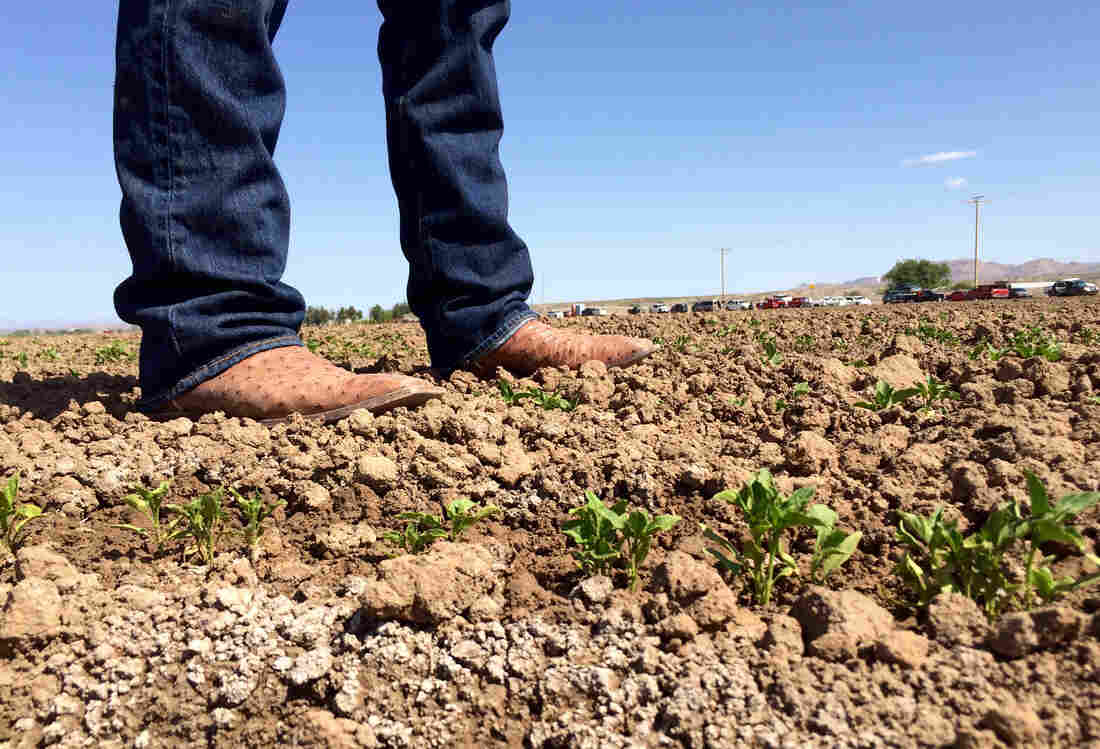Salt appears in white clumps in a newly sprouted chile field in Garfield, N.M. Mónica Ortiz Uribe/KJZZ hide caption
itoggle caption Mónica Ortiz Uribe/KJZZ
For some people, too much salt is bad for health. Too much salt is also bad for growing most crops.
Salty soil is a common problem for farmers in the arid West and it’s gotten worse because of the ongoing drought. Water is necessary to flush salts out; without it, salt builds up over time.
In New Mexico, one crop that’s suffering is the state’s beloved chile pepper.
Chile is not just a crop in New Mexico — it’s an identity. Whether red or green, the long leathery pepper with its unmistakable aroma is the reigning ingredient in local cuisine. It’s posted on road signs, arranged in vertical wreaths for decoration and protected by state law from impostors. But lately the state’s chile crop has been declining.
Joe Paul Lack is a farmer who married into New Mexico’s chile dynasty. His wife’s family is credited with commercializing a mild green pepper known as Big Jim.

Dried red chile pods for sale in Hatch, New Mexico’s chile capital. Susan Montoya Bryan/AP hide caption
itoggle caption Susan Montoya Bryan/AP
“This is the third year that I have not had one acre of chile,” he says. “I’ve been farming since the ’70s, so yeah, that hurts.”
Lack farms in southern New Mexico, near Hatch, the state’s chile capital. Foreign competition and labor shortages are partly to blame for the shrinking chile acreage. But so is drought.
Dry weather forces farmers to pump from underground aquifers. The water spills into irrigation canals that flow onto fields, making up for a short supply in the neighboring Rio Grande. But while groundwater can be a blessing, it’s also a curse.
“The aquifers tend to be salty,” said Stephanie Walker, a vegetable specialist at New Mexico State University.
Salt is part of a geologic legacy beneath the desert, leftover from ancient oceans that once covered the West. The shallow aquifer under New Mexico’s chile fields concentrates the salt. Experts estimate salt content there has quadrupled in the last four years.
“The longer growers have to pump water … the more detriment to the vegetables that they are trying to grow,” Walker says.
The detriment comes in the form of root damage, which weakens certain crops, like chile. In New Mexico, production is down 40 percent from record highs a decade ago. That’s despite better farming techniques that allow farmers to grow seven times more chile per acre than they did back in the 1990s.

In the absence of water from the neighboring Rio Grande, farmers have taken to pumping from underground aquifers. The salt content in groundwater builds up on the soil and harms certain kinds of crops, like chile. Mónica Ortiz Uribe/KJZZ hide caption
itoggle caption Mónica Ortiz Uribe/KJZZ
“What we need is a couple of monster snow seasons,” says Phil King, a civil engineer and consultant for the Elephant Butte Irrigation District.
Like the Colorado River, the Rio Grande depends on snowmelt. The more water in the river, the more water to flush away the salts. But as global temperatures rise, scientists predict there will be less snow to feed rivers. One federal study says the Rio Grande could lose a third of its flow by the end of the century.
“Our whole system is predicated on having a supply of fresh river water from the north, and if we don’t we are simply not sustainable,” says King.
The battle against salt is happening across the West. It’s fallowed more than 100,000 acres in California’s San Joaquin Valley. Salty runoff from farms in the Colorado River basin was what prompted the federal government to build a desalination plant in Yuma, Ariz., after years of complaints from Mexican farmers downstream.
“We have a tendency to utilize our resources to their fullest capacity and then go through painful downsizing when necessary,” King says.
The Elephant Butte Irrigation District, which covers 90,640 acres in southern New Mexico, is making an effort to combat its salt problem in an era of little water. Farmers are installing drip irrigation, which uses less water and pushes salt away from a crop’s root zone. The district is also looking into creating systems that capture storm water.
No matter the challenges, farmers pledge to not let their state’s beloved chile pepper die. Those who have stuck it out say they’ll continue until nature forces them out.
This entry passed through the Full-Text RSS service – if this is your content and you’re reading it on someone else’s site, please read the FAQ at fivefilters.org/content-only/faq.php#publishers.
